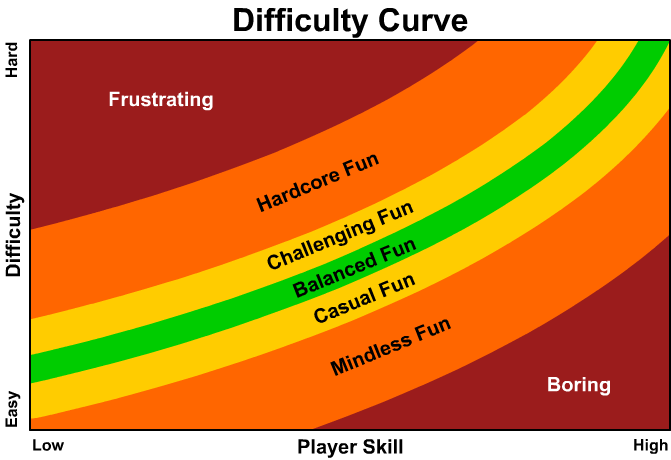Difficulty in games is something that determines how challenging a game is, or how difficult the challenges are. For example, if there is an enemy you need to destroy to collect a key off them to progress the level. Low difficulty could give the enemy low health so it can be killed quickly, or doesn't do as much damage to the player. Medium difficulty could give the enemy increased health, attacks that do more damage and give the enemy more abilities that the player has to watch out for.
In most games, difficulty can be changed to suit the player's style, if they are new to the game or are not very good players they can opt to have a low difficulty - making te challenges easier to accomplish according to their skill level. Veteran players, or players who may already be familiar with the game (From a prequel or playing several similiar types before) may increase the difficulty for a greater challenge, or so the game is not too easy, and thus boring.
Balance is also a primary component of games that has to be taken into consideration at all times, balance defines the 'learning' curve of a game, player skill progression, character development and increase in difficulty. Designers must take balance into account when developing a game to ensure it can stay enjoyable, but isn't boringly easy, or frustratingly difficult - Which diminishes gameplay value and enjoyment.
- For example, making a game too easy will offer no challenge, and challenges are the main component of a game, so with an easy challenge the game becomes boring.
- If a gamer will always strive to become better and stronger, making a game too difficult will block a player from becoming strong enough to overcome that challenge at an acceptable difficulty rating. Why would a player play a game if they can't even defeat a challenge that's too difficult? Only hardcore players would endure through it, which means most other aduiences will be pushed out which is bad for profit and popularity. Players would give up knowing they are putting in all that effort and getting no reward for it because they can't defeat the challenge.
Balancing a game can be done in a variety of ways, the main one employed by most games is an actual difficulty setting. For example you may select "Easy, Medium or Hard" modes as you play a game, this would affect things such as enemy health, enemy skill (Aiming skill, fighting efficienty etc) Some games even allow for the player to change the difficulty in mid-game such as Skyrim, Oblivion and Two Worlds II, The second way is to make the start of the game easy, player skill will most likely be low because of their unfamiliarty with the game and its mechanics. Players would progess through this and become attuned to its workings and gameplay, thus become better and smarter at the game, as a response, difficulty usually increases to reflect this - Presenting new challenges the player can attempt with their new skill sets - This keeps the game enjoyable, without being too hard nor too easy but keeping the player striving for better abilities, equipment or a progression of story line at a comfortable rate.
Some games of course break this for the pure sake of targetting a particular audience, for example the Dark Souls game is exceptionally anti-newb friendly and is very difficult to play, there are no difficulty settings and the difficulty progression remains high. This gives players a great challenge and would put off most casual gamers (Within the first 20 minutes there's a boss you cannot kill!) Dark Souls even brought out a version called "Prepare to die edition"

Structures of challenges:
There are three common ways of progressing a game, or providing play a means to travel from level to level, challenge to challenge. Although there are three main ways, they can all be included in the same game to add variety to how a player may progress through levels and challenges.
Linear Structure
- A linear structure defines a game where the play progresses from various levels in a straight forward fashion. Level 1 > Level 2 > Level 3, players can only progress forward and can never revisit a level they have already completed.
- Examples of games with a linear structure:
The Halo series all have linear structure, the player has a set series of levels that the player progresses through. Level 1, the player has X challenge to do (Capture an objective) which leads to Y challenge (Hold the objective for 5 minutes) Then level complete. The player then progresses to level 2.





